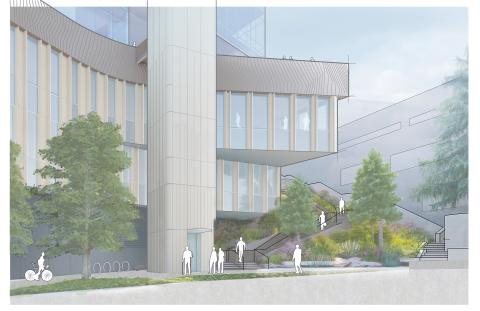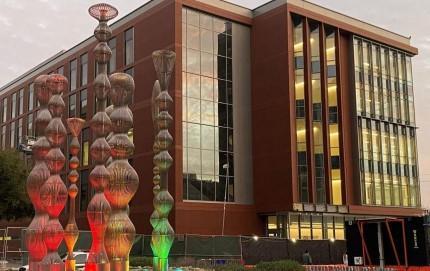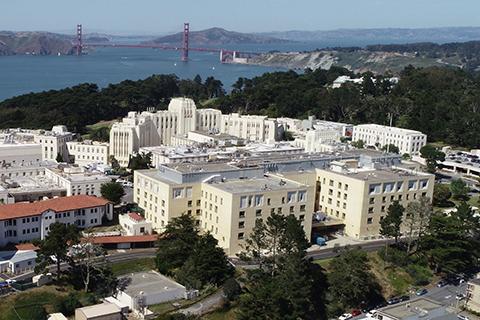Space: The Final Frontier for the Department of Medicine
One key responsibility of leaders is to manage scarce resources in a manner that allows the organization to best fulfill its mission. While the resource that usually leaps to mind is dollars, it turns out that managing physical space can be every bit as important, and sometimes even more challenging.
In an expensive city with seismic issues, it’s inevitable that space is a precious resource. Moreover, the myriad types of space needs in an academic health center (basic research labs; clinical research space; offices for faculty, staff, and trainees; educational and classroom space; and clinical space) and the variety of “owners” of the space (UCSF campus, School of Medicine, departments, and three different health systems) – all ensure that aligning space with needs will be wildly complicated.
There is a lot of construction on all our campuses these days, which adds to the complexity and the opportunity. And the confusion. Today, after a brief overview of how space works at UCSF, I’ll provide an update on the major space moves and their impact on our department. The goal is to demystify the space process and to help everyone see the big picture when it comes to space management.
The Nuts and Bolts of Space Across All of Our Missions
Until recently, the UCSF campus was responsible for all the space at Parnassus, Mt. Zion, and Mission Bay, while space at ZSFG and the VA was owned and overseen by the City and County of SF and the US government, respectively. The first major exception to this rule was the city’s decision to allow UCSF to construct a new research building at ZSFG on city-owned land. That building, now known as Pride Hall, offers 175,000 square feet of modern and attractive UCSF-owned space for research activities on that campus (more on this later).
Space at Parnassus, Mount Zion, and Mission Bay is divided into health system space and campus space. UCSF Health, our healthcare delivery system, owns and operates substantial space on all three of these campuses for the purpose of delivering clinical care. Decisions about building, buying, or renovating this space are made by UCSF Health leaders – generally after extensive consultation with the relevant clinical departments. These decisions are driven by the need to meet important clinical goals and, given the economics of clinical care, the expected return on investment.
On the other hand, non-clinical space (research, non-clinical office, and educational space) is owned by the campus and distributed to entities based on their size and requirements. The School of Medicine, constituting approximately 90% of UCSF’s faculty, has control over the lion’s share of non-clinical space. The SOM subsequently assigns space to departments for them to manage according to their needs. The DOM, representing nearly 30% of SOM faculty, receives a space allocation that is roughly proportional to its relative size. In keeping with the principle of space delegation, given its vastness (with 15 divisions at UCSF Health alone), our department further allocates space to our divisions (similarly based on size and needs) and delegates management responsibilities to them. (In contrast, smaller departments are likely to retain central control over all their space.)
While all of this is complicated enough, several megatrends are changing the dynamics of space on both the clinical and non-clinical sides of our operations:
a) UCSF Health has been experiencing tremendous growth over the past decade, both in UCSF-owned and affiliated network sites. For the former, we turn away literally thousands of patients a year because of a lack of both inpatient and ambulatory space. In addition, most UCSF clinical buildings are over 30 years old, and the costs of maintenance and modernization are prohibitive. All of this has led to an investment in building a substantial amount of new clinical space and the decision to acquire two hospitals from another health system, CommonSpirit (formerly Dignity). More on this later.
b) DOM’s basic research (sometimes called “wet lab”) enterprise is growing at a steady pace (partly tied to the NIH budget, since federal funding supports most laboratory research). We have outgrown our existing lab space, and some of the space we are using (most palpably in the two Parnassus research towers) is decades past its prime. Thus, there is considerable pressure to build new, modern lab spaces. The finances of building and maintaining research space are mostly managed by the campus, with space supported by indirect payments on sponsored research grants from funders, often supplemented by philanthropy. (While our researchers often point to the fact that they receive only a small portion of the indirect payments on their grants, they also receive their space at no cost. In contrast, several of our peer institutions return a larger percentage of indirect costs to principal investigators but require them to pay rent for their space – a strategy designed to prevent the hoarding of space that inevitably occurs when it is “free.” There is no perfect system.)
c) Dry space – designated for faculty and staff offices, workrooms, clinical researchers, and the like – has become the most dynamic part of our space equation. Pre-pandemic, demand for this space was as intense as for the other two categories. Due to the expansion of remote work within our department and UCSF as a whole, much of our dry space (including the beautiful new space in the Parnassus Clinical Sciences Building, CSB) is markedly underused. Consequently, we have initiated departmental efforts to assess our space use and allocate it according to actual need and usage. This is a complex process that understandably creates some concerns.
With this as background, here’s a brief update on space considerations at our three main sites – UCSF Health (including Parnassus/Mt. Zion/Mission Bay), ZSFG, and the VA.
UCSF Health Sites
Clinical Space at UCSF Health
UCSF Health has invested hundreds of millions of dollars in new clinical spaces over the past several years, mostly at Mission Bay (the Bakar Precision Cancer Medicine Building and the Wayne and Gladys Valley Center are the ones most relevant to our department). During the pandemic, new inpatient clinical space opened at Mt. Zion, and significant remodeling of selected floors at Parnassus was completed. Despite these efforts, our capacity remains well below our needs, and the cost of renovating decades-old space is prohibitive. Moreover, current state regulations mandate major seismic upgrades of all hospital spaces by 2030, which will render some of our existing space unusable for patient care.

In the face of these pressures, UCSF Health has made two transformative investments. The first is the decision to build a large new tower at Parnassus on the site of the Langley Porter building. This new tower, with an estimated cost of $4.5 billion and an opening date in 2030, will provide state-of-the-art facilities at Parnassus, including a new ER, dozens of ORs and procedure suites, and over 100 ICU beds. The new tower will connect to the Long Building (which will stay open as a clinical facility) on several floors. Much of Moffitt will close as a clinical facility (its future use is yet to be determined), although a few floors will remain operative as hospital wards after some retrofitting. While the cost is daunting and the construction will cause a significant amount of disruption, there is no question that Parnassus (where most inpatient DOM care is delivered) needs this upgrade, and the opening of the new hospital building should usher in a very exciting time for the Parnassus campus.
With the new hospital seven years away and the construction process sure to lead to some temporary capacity loss, UCSF Health urgently sought access to additional clinical space in the next few years. Fortuitously, while our clinical sites are running at 100% (or more) full, the two hospitals in San Francisco owned by the CommonSpirit system, St. Mary’s and St. Francis, have been running at less than 50% of capacity, leading to substantial deficits. Negotiations are ongoing but UCSF Health is highly likely to acquire these hospitals (along with some affiliated clinics) at a cost of approximately $100 million. This acquisition will provide us with an additional 500 beds in the next two to three years. (By contrast, the new Parnassus tower will add only a few hundred beds to our overall capacity, in part because of the loss of beds in Moffitt.) Although St. Mary’s and St. Francis will require significant investments in infrastructure and staffing, we couldn’t afford not to take advantage of this opportunity given our space crunch. One way to think about it: our $4.5 billion investment at Parnassus will create approximately 300 new beds – a cost of $15M/bed. The acquisition of St. Mary’s and St. Francis will provide us access to 500 beds at a purchase price of $100M, which comes to $200K/bed. Even accounting for substantial investments in staffing and refurbishing that will be required for the CommonSpirit facilities, the purchase makes tons of sense.
Laboratory Space at UCSF Health

Lab space at our UCSF Health sites poses a challenge. Most of the DOM’s lab facilities are at Parnassus. Other departments, whose clinical centers of gravity are at Mission Bay, plus the basic science departments, tend to have their labs based there. Like the clinical facilities at Parnassus, Parnassus-based labs are also aging, and not particularly gracefully. The DOM has negotiated for additional lab space in the Koret Building, formerly the home of the Ophthalmology department, on the west end of the Parnassus campus, which helps. But the real game-changer is the construction of a new dedicated Parnassus Research and Academic Building (PRAB) in the old U building at Parnassus, slated to open in 2027. The PRAB will house a substantial number of new laboratories, many of them for DOM investigators. Moreover, by providing space for investigators to move out of the HSE and HSW towers (some permanently, others temporarily), the opening of the PRAB will allow for the much-needed refurbishment of the towers over the next few decades.
Office and Classroom Space at UCSF Health
This category should be the easiest, since virtual work has massively decreased the demand for non-lab, non-clinical space. But this has given rise to a new issue – lots of expensive vacant space, which is not only inefficient but unfair when some groups truly need office space. In response, we conducted a space inventory in the spring, during which my staff walked around all our DOM Parnassus spaces, both observing the space utilization and leaving “we missed you” notes in empty offices, encouraging occupants to contact us. The inventory revealed a substantial amount of underutilized space. We are soliciting plans from divisions for their space and are considering reallocating some of the underused space to divisions with genuine space needs. For our part, the Chair’s Office has relinquished approximately half of its space to faculty, staff, and trainees, as many of our staff now work from home part of the time.
Space at Zuckerberg San Francisco General Medical Center
Clinical Space at ZSFG
At our ZSFG campus, the need for new inpatient clinical space was addressed with the opening of the new hospital building, Building 25, in 2016. There are ongoing efforts to provide modern ambulatory space for some of our practices.
Research and Academic Space at ZSFG (and Partly Mission Bay)
At ZSFG, research space for DOM investigators on the ZSFG campus is undergoing a seismic transition, both literally and figuratively, with the opening of Pride Hall. For the first time in the 150-year partnership between UCSF and ZSFG, UCSF research and academic groups at ZSFG will be housed in a UCSF-owned building, which is fully compliant with current seismic codes. The need for this building arose from the inadequacy of the existing research space but became mandatory when new seismic standards forced the closure of all UCSF research programs (mostly led by DOM investigators) in the red brick buildings, as well as Building 3 (the one with Carr Auditorium on the ground floor).

While the opening of Pride Hall this summer represents a major investment by the University in the research community at ZSFG and will no doubt foster new collaborations and synergies, there have also been major challenges with the transition. The space plans for Pride Hall were established before we knew that the buildings housing the Orthopedic Trauma Institute, Pathology, and DOM’s Division of Experimental Medicine (the largest wet lab division on the campus) were no longer compliant with current seismic codes. Incorporating all these groups into the pre-existing Pride Hall footprint resulted in very high density, threatening the productivity of many research groups. To address this challenge, the ZSFG research community and DOM leadership engaged in sustained advocacy efforts to decompress the research spaces in Pride Hall.
We are pleased that these advocacy efforts are starting to bear fruit, with new research space being made available to ZSFG investigators on the Mission Bay campus. UCSF has signed a long-term lease for recently vacated research space on the 2nd floor of 499 Illinois St., the building that houses the Chan-Zuckerberg Biohub (CZB). This space, located across 3rd Street from the UCSF Mission Bay Hospital, will be allocated to ZSFG wet and dry labs in DOM’s Divisions of HIV-ID-Global Medicine and Experimental Medicine as well as the Department of Anesthesia. This development will create a dynamic new research community on the Mission Bay campus, which synergizes with both the CZB and the ZSFG research communities remaining in Pride Hall. It will also go a long way toward alleviating the congestion in the research spaces in Pride Hall for those who remain.
To be sure, many challenges remain in Pride Hall, including ensuring equitable space redistribution, addressing compressed dry lab and office areas, and resolving issues in the building’s community and clinical research center and the off-site biospecimen storage facility. Nevertheless, our DOM research community at ZSFG, responsible for >$110M in annual sponsored research revenue (36% of the DOM’s overall total of $360M annual research revenue), continues to demonstrate great strength and resiliency, working together to meet these challenges and forge a dynamic new future at both ZSFG and Mission Bay.
Space at the San Francisco VA Medical Center

At the San Francisco VA Medical Center, few issues are more charged than space allocation. Located on the 200-acre Ft. Miley site in the northwest corner of the city, its original buildings were constructed in the early 1930s. While newer structures, including the current hospital, were erected in the 1970s, later campus improvements slowed due to concerns related to historic preservation, neighborhood objections, and limited budget appropriations. To facilitate upgrades needed for expanding clinical and research activities, several options beyond Ft. Miley were considered, including the relocation of many VA activities to Mission Bay. Ultimately, the decision was made to retain the Ft. Miley site, kicking off a series of plans for structural improvements.
The campus is now beginning a decade-long journey of demolitions, seismic retrofitting, renovations, and new construction. Clinical and research faculty are already feeling the squeeze of insufficient space, and the situation is expected to worsen as demolition and building closures necessitate “swing space” to accommodate displaced services. These pressures are slated to last up to 10 years until construction concludes.
Most DOM activities at the VA are centered in the inpatient building, Building 203. Over the past year, members of Medical Service leadership, Hospital Medicine, and the Medicine Residency demonstrated their adaptability, resilience, and grace when required to vacate their core offices in the hospital building to make way for a new 16-bed short-stay rehab unit. This transition was an uncomfortable and chaotic time for over 30 faculty and staff – and innumerable trainees – and the change resulted in a 25% loss of space and beloved ocean views. Despite these challenges, clinical, educational, and administrative activities were maintained with few complaints, and the first veterans were welcomed to the new rehab unit this summer.
Additional renovations on the inpatient side include the creation of a dedicated wing for rehab, orthopedics, and integrative health, along with a new psychiatric unit. On the horizon, within the next three to seven years, are major upgrades to the ICU (constructed in 1950s) and the GI Suite (renovated in the 1990s). Each of these projects will require relocating these large and vital clinical areas, thereby dramatically impacting inpatient bed availability, offices, and other operations such as pharmacy and nursing.
Additional buildings facing major upgrades include:
- A new sleep medicine/mental health facility opened in June 2023
- A major mental health building has been vacated, and retrofitting is beginning
- Demolition of two of the VA’s most historic buildings to clear the way for construction of a new wet-lab research facility
- Additional demolition in 2023 of an original research building and old animal lab
Conclusion
As you can see, there is an enormous amount of space-related activity at UCSF – more than at any time since the opening of the Mission Bay campus twenty years ago. When the dust settles, we’ll have new clinical, research, and academic facilities on all our campuses, which will allow us to deliver better care to more patients and elevate our research and educational efforts to new heights. The growth in virtual work, including telemedicine, introduces some unknown variables to the equation. Unfortunately, progress comes at a cost, and the cost will be both in dollars and in considerable disruptions in the next few years. In the end, though, no organization can succeed if the quality of its space fails to match the quality of its people and their work, and so I am exceptionally excited by what’s on the horizon.
Robert M. Wachter, MD
Chair, Department of Medicine
(With assistance on ZSFG and VA portions by Peter Hunt/Neil Powe and Heather Nye/Ken McQuaid, respectively)